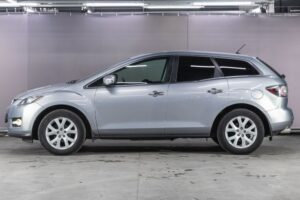It had been as long as 1994 since Mazda had released a mid-sized SUV, and that would be in the form of the Mazda Najavo.
Mazda sought to get back into this market as in January 2006, concepts for the car would be shown in the LA auto show, and in the following months, the 2007 Mazda CX-7 would hit stores and dealers in April of 2006 a 2007 model.
The Mazda CX-7 was not on the same platform as the Mazda CX-9, so it was placed below it.
The Mazda CX-7 used the Ford C1 platform, which is used to target the Ford Focus and give competition to its sibling lineup, the Mazda 3.
Despite the best efforts of the Mazda CX-7 and how little there were of either, the lineup would be discontinued in 2012 in favor of the Mazda CX-5, a compact crossover SUV which started its production in the same year.
Here are the best and worst years for Mazda CX-7. Since there are only 6 years total for the lineup, these lists will be shorter than usual.
Best Years for Mazda CX-7:
- 2012
- 2009
- 2011
Worst years for Mazda CX-7:
- 2007
- 2008
- 2010
Apart from discussing these six years in great detail, I will also discuss the various issues surrounding the models and their common questions.
Table of Contents
List Of The Best Years For The Mazda CX-7: What Years To Buy

Despite its short existence, half of the Mazda CX-7’s models were just outstanding, featuring a lot of power and performance, with no major problems either.
#1 Best Year: 2012 Mazda CX-7
I have placed the 2012 Mazda CX-7 at the top of this list because this model was the last in the lineup.
By that time, the company had not only been able to eradicate most, if not all, of the problems affecting the Mazda CX-7.
Still, it delivered a solid driving and riding experience before the sad announcement of the series’ discontinuation.
Reliable and fun to drive, the Mazda CX-7 featured a great interior, amazing mileage, and a lot of reliability as per car owners, giving it a definite first place on this list.
The last year of the series featured a total of 6 different trims, all of which had responsive steering, staggering acceleration because of the included turbocharger, great break-pedal feel, and a perfectly arranged cargo area that could store all of you and your family’s needs, the Mazda CX-7 is, after all, a car targeted towards small families.
Apart from being a great family SUV, the vehicle offers powerful towing capabilities, which it achieves with both its standard engine and the optional 244-hp turbo 4-cylinder.
Available in FWD & AWD, the vehicle features a myriad of safety features and interior comfortability features, many of which are standard and many that are optional in case you do not think they are must-haves.
Overall, the vehicle is the best in the series and the culmination of all the years before it.
#2 Best Year: 2009 Mazda CX-7
Taking the 2nd spot on this list is the 2009 Mazda CX-7, which only had three different trims in the year but had a lot of pros to back up the lack of options.
Featuring excellent acceleration and handling, the year brought an appealing style to the model and a lot of new standard features, which bumped up the riding quality of the car.
The interior was also no joke as the cabin materials were high quality, and the back seats could be folded to make more space for storage.
The standard engine also boasted 244 hp and a turbocharger, with a 6-speed automatic transmission and AWD versions.
Despite the turbocharger demanding premium fuel, which is in actuality always good for your car, and the cargo area not being as big as it should be, the vehicle offers a lot of fun in its drive and safety with its interior, making it worthwhile.
This is why I am placing this model in 2nd place.
#3 Best Year: 2011 Mazda CX-7
Before the release of the 2012 model, the 2011 Mazda CX-7 was also forming its position among fans and owners of the vehicle.
Many of the same features of the 2012 model, as the 2012 Mazda CX-7, did not have any significant changes.
The 2011 model also boasts amazing cargo space, steering and brake feel, and fast-paced acceleration.
It isn’t higher up on this list because the car suffered from 4 different recalls and had frequent headlight issues, which hurt its overall position on this list.
This year had five different trims of the vehicle, and they all featured a few styling tweaks here and there, giving the year a new feel.
The company also heard the complaints of the 2010 model and decided to incorporate a more efficient and non-turbocharged base engine in addition to the turbo 4-cylinder.
Providing a firm and faced ride, the new base engine, and improved mileage made this model stand out along with the drop in price, which went along with these changes.
List Of The Worst Years For The Mazda CX-7: What Years To Avoid

The other half of the Mazda CX-7 models are full of problems and annoyances, making them vehicles I definitely would not recommend.
#1 Worst Year: 2007 Mazda CX-7
I am placing the 2007 Mazda CX-7 in first place on this list due to the massive amounts of problems the year introduced.
Despite being the first year of the series, the lineup was already facing a lot of different issues, which is to be expected from the first model of any lineup, which is why you should always avoid the first model of any lineup unless it has been reviewed before its release or until considerable time has passed.
The 2007 CX-7 has the most complaints in the entire lineup, and many of the issues affecting the lineup happen to occur at very low mileages, making it the worst year for the series.
The NHTSA filed numerous reports regarding the engine and air conditioning problems.
Among these problems was a trend of the turbo failing at low mileages, the Variable Valve Timing and timing chain failing, and major engine damage, which would lead to owners calling replacement engines.
There was a clear pattern of the air conditioners compressor failing at low mileages. The Serpentine belt would catch fire, and owners would report smoke.
Things got so bad for the Mazda CX-7 that a special program was launched that extended the year’s warranty to 7 years of 70,000 miles.
However, the coverage of this new warranty would require perfect documentation, which is easy to mess up.
#2 Worst Year: 2008 Mazda CX-7
Taking the 2nd spot on this list is the 2008 Mazda CX-7, which tried to better than the 2007 model and was able to cut down on a lot of problems but was still not able to fully get a grip on the situation, having the second-highest count of problems and complaints in the entire series which is mainly the reason I have ranked it here.
Many of the engine-related and AC-related problems of the first model came back to haunt the second one, as well as the timing chain and the VVT were still failing and causing a great deal of engine damage.
The AC was still suffering from compressor failure, and the belt was still catching fire.
What’s worse is that all of this would be happening early into the car’s lifetime and would miraculously happen just outside the warranty limit of the car.
Apart from these issues, the model was also recalled on the grounds of the Takata recall, which could explode and fling metal fragments towards passengers when activated.
#3 Worst Year: 2010 Mazda CX-7
The 2010 Mazda CX-7 takes the 3rd and final place on this list because this year faced the same engine defects as the previous two models.
This meant that this model also suffered from the Variable Valve timing failure, timing chain stretching/failure, and turbocharger failure.
These issues are very costly and quite frequent in the models, which is why it is disappointing to see why the Mazda CX-7 was unable to fix these problems and makes sense as to why the lineup was underperforming.
This year’s models were also affected by the Takata recall, yet another huge negative for the year.
Various complaints from the NHTSA were filed regarding these airbags, along with the lights and the suspensions of the vehicle.
The headlights of the 2010 Mazda CX-7 had a bad habit of burning out, resulting in the housing area melting.
The suspensions made a rattling sound, and there was the issue of ball joint separation, which would lead to a loss of steering control.
This issue led to a recall which affected more than 190,000 cars.
What Are The Most Common Problems With The Mazda CX-7?
While the discontinuation of the Mazda CX-7 is sad, it is justified when considering the many common problems the model faced.
While they may not have been the reason for its discontinuation, I will discuss the common problems affecting the Mazda CX-7 anyway.
1. Takata Recall
Like many other cars, among the millions of units recalled by the Takata recall, the Mazda CX-7 suffered a major recall regarding the vehicle’s airbags.
The issue was that upon being activated, the airbags would explode. This explosion would also fling metal components towards the passengers, causing injuries.
Affecting more than 30 million cars, the issue was resolved and fixed. However, certain cars which may not have acted on the recall could still pose such an issue.
2. TPMS Valve Stem Corrosion
Since the September of 2007, every vehicle sold in the united states was required to have a Tire Pressure Monitoring System which electronically monitors the air pressure inside the car’s tires as vigilant monitoring can allow for fewer blowouts and more MPG.
The first generation of the Direct Tire Pressure Monitoring System developed a habit of corrosion that would damage the sensors.
This issue resulted in a very expensive problem that had to be resolved. Otherwise, it could result in tire failure.
3. Variable Valve Timing
The Variable Valve timing of a car is very important as it uses technology to open and close the engine’s valves to increase fuel economy, generate more power, and limit emissions.
The Mazda CX-7 used a very complex VVT system with a defect that led to costly problems.
The VVT was exposed to constant wear and tore and would tick loudly when starting the engine. It also affected the timing chain and caused it to stretch excessively.
4. Engine Issues
Apart from various issues affecting the engines of many Mazda CX-7 models, the main cause for concern was the turbo which was prone to failure and malfunctioning.
Customers have complained about the turbocharger blowing up at fairly low mileages, leaking causing a loss of power. All of this would result in white smoke coming out from the exhaust.
The only way to fix the issue would be to get a new turbocharger which is a costly endeavor.
5. Interior Issues
The Mazda CX-7 is known for having failing door seals.
This would result in a creaking noise from the front doors as you drive the car. This issue was fairly simple and needed replacement door seals.
Another common issue faced by the interior was that the trim between the base of the front seats and the floor would break.
This is due to the cheap plastic used to make the trim which is easy to break off and come loose.
Frequently Asked Questions
Q1. How Many Miles Can I Get Out Of A Mazda CX-7?
Being fairly reliable, the Mazda CX-7 has a very good life expectancy of over 200,000 miles, beyond which it may become infeasible to drive the vehicle due to the amount you would have to spend on repairs.
However, you can avoid all of this by making sure that the car receives regular maintenance and care as it will not only boost the car’s performance but also bump up the life expectancy to beyond 250,000 miles, which is just solid.
Q2. Why Was CX-7 Discontinued?
Customers and fans of the Mazda CX-7 were sad to know that the company would discontinue the lineup as of 2012.
There were two main reasons why this situation even occurred.
The first one was regarding the total lack of sales the Mazda CX-7 generated, which is very understandable.
This probably had to do with the second reason, as well as the Mazda CX-7 was overshadowed and outperformed by the Mazda CX-5, which was smaller and more versatile.
Q3. What Is The Difference Between The CX-5 And A CX-7?
Knowing the Mazda CX-5 is integral to understanding why the CX-7 was discontinued.
The Mazda CX-5 boasts a better compression ratio, longer piston, less fuel consumption, better mileage, fewer emissions and is better than the CX-7.
The Mazda CX-5 is also 2% shorter than the CX-7, weighing less and still somehow capable of storing more cargo, making the reasons clear as to why the CX-5 put the CX-7 out of commission.
Q4. Is Mazda CX-7 A 4-Wheel Drive?
The short answer is yes. While many people think AWD & 4WD are the same, it is not. The Mazda CX-7 is a 4-wheel drive.
Four-Wheeldrives are great for off-road situations, and while the Mazda CX-7 is a 4WD, it also features FWD & AWD in its various trims making sure that the vehicle is fit for all types of terrain and allows the customer to choose the trim they want so that it they can ride it according to their location and the type of roads they face.
Q5. Does The Mazda CX-7 Have A Timing Belt?
This is a very common question when inquiring about the Mazda CX-7. No, the Mazda CX 7 does not use a timing belt when it comes to timing belts.
Instead, all models of the Mazda CX-7 use a timing chain. While they are both fundamentally the same, belts are made of rubber, while chains are metal.
A timing chain is better as it is stronger than the timing belts but costs more.
Conclusion
While not all models of the Mazda CX-7 made waves in the market, the 2012 Mazda CX-7 made a lasting impression on fans as the last of the series, despite the bad launch of the 2007 model, which was full of problems.
While it was a short run, it was still an honorable effort as the Mazda CX-7 was a wonderful vehicle that was not only praised for its high safety standards but its amazing performance and handling.
In any case, now that you know the best and worst years for Mazda CX-7, you can revel in the knowledge of the series, and if looking for a used model, easily choose the best model and avoid the worst ones listed above.

I am Tahir Azam, and I have been writing amazing articles for TaxiHack for as long as I can remember. I know everything that is to know when it comes to automobiles and is always on top of industry news and developments. While I am not an expert by any means, I pride myself on knowing the ins and outs of many different problems and, of course, their solutions. The articles on our website are some of the best and well-researched content that you will find, and I spend countless hours making sure this remains to be true. This is why I ask you to take your time out and read some of my articles, especially if you find a topic that resonates with you or is something you are looking into. This way, you will find the perfect mix of information and tips on your desired topic. Learn more about Tahir.

